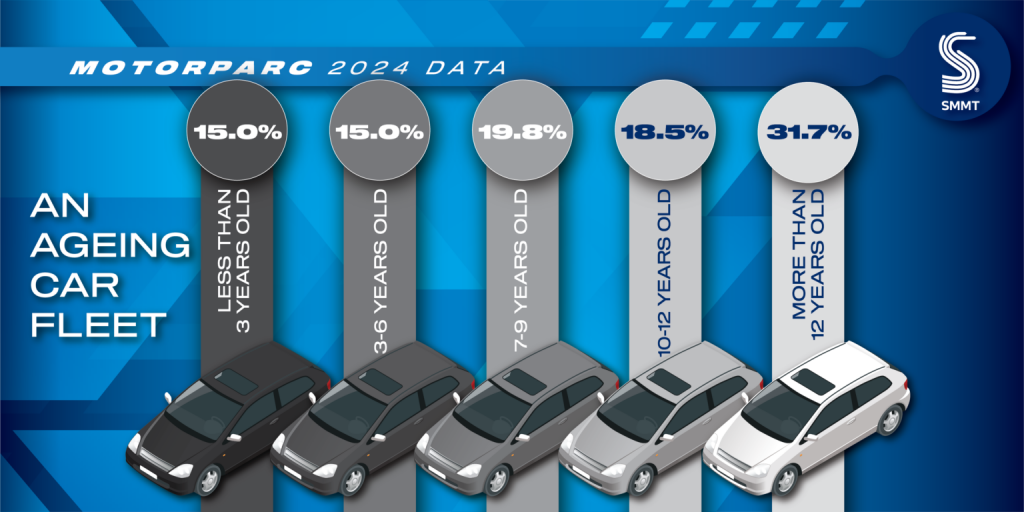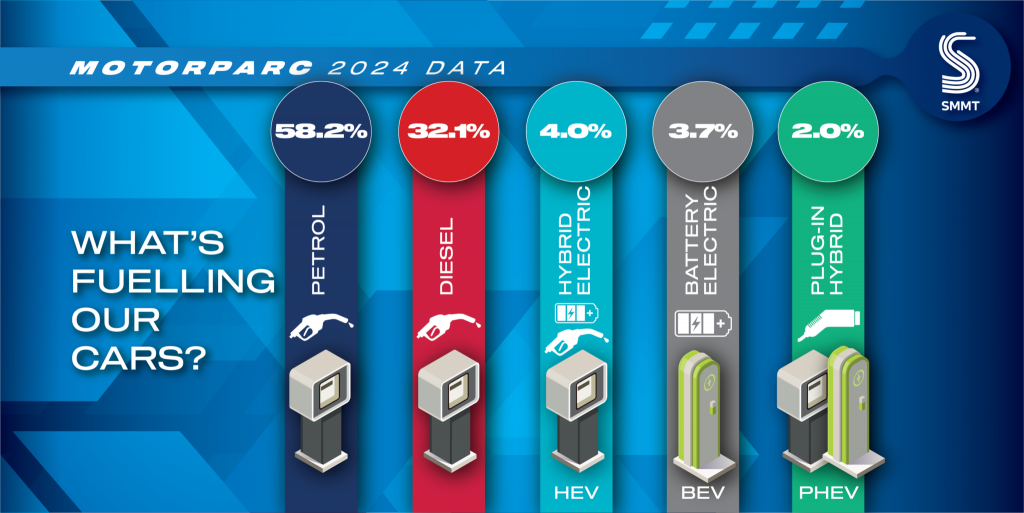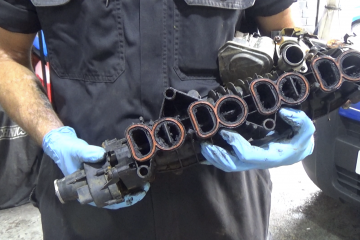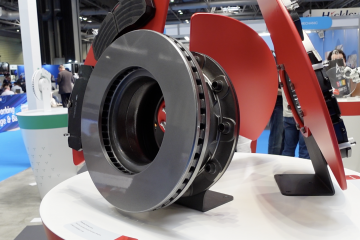The number of cars on UK roads increased by 1.3% last year, as the parc continued to age.
A total of 36,165,401 passenger cars were on the road last year, according to the latest car parc data from the SMMT. This marked the third consecutive year of growth, and the second-biggest volume gain since 2016. The growth reflects improvement in the new-car market, where 1.95 million cars were registered last year.
However, with low uptake in the new car market, the increase in the number of cars on the road means the car parc age continues to rise. The average age of a car on the road is now 9.5 years, up from 9.3 years in 2023, and much older than the eight-year-old average of 2019.
Car parc age increases again
The car parc age bands shifted in 2024. Those less than three-years-old made up 15% of the total, up by 0.6 percentage points (pp) compared to last year. Models between three and six years also made up 15%, a drop from the 17.1% in 2023, suggesting a large number of vehicles crossed into the next band. This seven to nine-year old segment made up 18.5% of the car parc, up 1.4pp.

Finally, 31.7% of cars in the parc were more than 12-years old. This was a rise of 1pp compared to last year. Therefore, the UK’s car parc age is shifting towards the older end of the spectrum. Just over half of models on the road, equating to 18.15 million units, are over a decade old.
Additionally, 85% of cars are over three-years old. This is the average age for a vehicle to enter the aftermarket. Therefore, 30.74 million cars on the road could be relying on independent workshops.
As the average age increases more reliance on replacing parts and servicing will be required. Therefore, the aftermarket once again has an opportunity to lead the entire automotive industry.
Popular petrol
The car parc continues to decarbonise. Across the entire vehicle parc, there was a 34.6% increase in electric vehicles (EVs), made up of plug-in hybrids (PHEVs) and battery-electric vehicles (BEVs).

In the car parc itself, EVs make up 5.7% of the total. This is split into 2% for PHEVs, and 3.7% for BEVs. This has risen, with PHEVs up 0.4pp, and BEVs up 1pp year on year.
Manufacturer discounting has driven up demand for battery electric cars which saw them remain the fastest growing sector of the parc, breaking the million-motor milestone as volumes soared by 38.9% to 1,334,246 units.
However, 58.2% of cars, equating to around 21 million units, are still powered by petrol. This is a drop of just 0.1pp compared to 2023’s figures. Meanwhile, diesel made up 32.1%, a drop of 1.9pp, and equating to around 11.6 million passenger cars.
The share drop of diesel is consistent with that experienced between 2022 and 2023. It means around half a million units have disappeared from the car parc, the largest drop since 2021. This keeps a trajectory, calculated by Auto Repair Focus, that it would take at least 38 years before diesel cars disappear from UK roads.
Finally in the powertrain breakdown, 4% of models in the UK car parc were full hybrids, equating to around 1.4 million units. It is clear, therefore, that BEV are quickly catching up with the technology, which has been around for much longer.
Therefore, while conventional powertrains remain the most dominant, the number of electrified vehicles is increasing in share of the UK car parc, meaning workshops need to be more prepared than ever to see these vehicles through their doors.
Ford Fiesta leads
Superminis remain the most popular car type in use, closely followed by lower medium models. These segments account for 59.2% of cars on the road, making up 11,893,199 and 9,524,299 units respectively.

The most popular car in the UK remains the Ford Fiesta, with just over 1.4 million still on the road, over two years since the carmaker axed the model. The move appears to have been a mistake, and the Fiesta’s popularity could be adding to the aging car parc.
Second place went to the Vauxhall Corsa, with around one million units on the road in the UK, while the Ford Focus was third, with just over a million units in the car parc.
Automatic transmissions continue to rise as more electric vehicles reach the road, up 9.5%, while manual transmissions have fallen 2.6%. This is also significant for the aftermarket, with the more complex transmission type likely to dominate the market in the near future.
“Britain’s vehicle parc is growing, providing essential mobility for the nation while reducing its environmental impact,” commented SMMT chief executive Mike Hawes. “However, there is scope to push environmental improvements much faster as motorists are holding onto their cars for longer, some one and half years longer on average, than only five years ago.
“Drivers need more incentives and greater confidence in infrastructure investment if we are to replace the high volumes of older high-emission cars with zero-emission alternatives. Success will keep the country on the move while driving up economic growth from every business dependent on road transport.”




You must be logged in to post a comment.